The Diversity and Organization of Life
Section Goals
By the end of this section, you will be able to do the following:
- Describe the levels of organization among living things
- Explain the purpose of phylogenetic trees
- Explain how organismal relationships are indicated by the binomial naming system
Living things are highly organized and structured, following a hierarchy that can be examined on a scale from small to large. The atom is the smallest and most fundamental unit of matter. It consists of a nucleus surrounded by electrons. Atoms form molecules. A molecule is a chemical structure consisting of at least two atoms held together by one or more chemical bonds. Many biologically important molecules are macromolecules, large molecules that are typically formed by polymerization (a polymer is a large molecule that is made by combining smaller units called monomers, which are simpler than macromolecules). An example of a macromolecule is deoxyribonucleic acid (DNA) (Figure 1), which contains the instructions for the structure and functioning of all living organisms.
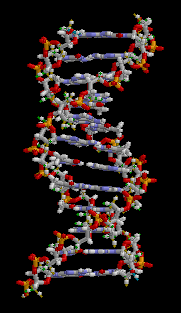
Some cells contain aggregates of macromolecules surrounded by membranes; these are called organelles. Organelles are small structures that exist within cells. Examples of organelles include mitochondria and chloroplasts, which carry out indispensable functions: mitochondria produce energy to power the cell, while chloroplasts enable green plants to utilize the energy in sunlight to make sugars. All living things are made of cells; the cell itself is the smallest fundamental unit of structure and function in living organisms. (This requirement is why viruses are not considered living: they are not made of cells. To make new viruses, they have to invade and hijack the reproductive mechanism of a living cell. Only then can they obtain the materials they need to reproduce.) Some organisms consist of a single cell, and others are multicellular. Cells are classified as prokaryotic or eukaryotic. Prokaryotes are single-celled or colonial organisms that do not have membrane-bound nuclei or organelles; in contrast, the cells of eukaryotes do have membrane-bound organelles and a membrane-bound nucleus.
In larger organisms, cells combine to make tissues, which are groups of similar cells carrying out similar or related functions. Organs are collections of tissues grouped together performing a common function. Organs are present not only in animals but also in plants. An organ system is a higher level of organization that consists of functionally related organs. Mammals have many organ systems. For instance, the circulatory system transports blood through the body and to and from the lungs; it includes organs such as the heart and blood vessels. Organisms are individual living entities. For example, each tree in a forest is an organism. Single-celled prokaryotes and single-celled eukaryotes are also considered organisms and are typically referred to as microorganisms.
All the individuals of a species living within a specific area are collectively called a population. For example, a forest may include many pine trees. All of these pine trees represent the population of pine trees in this forest. Different populations may live in the same specific area. For example, the forest with the pine trees includes populations of flowering plants and also insects and microbial populations. A community is the sum of populations inhabiting a particular area. For instance, all of the trees, flowers, insects, and other populations in a forest form the forest’s community. Keep in mind that the community level only consists of living organisms. The forest itself is an ecosystem; this is the first level that contains non-living aspects of a given area that impact the living things in that environment. An ecosystem consists of all the living things in a particular area together with the abiotic, non-living parts of that environment, such as nitrogen in the soil or rainwater. At the highest level of organization (Figure 2), the biosphere is the collection of all ecosystems, and it represents the zones of life on Earth. It includes land, water, and even the atmosphere to a certain extent.
From a single organelle to the entire biosphere, living organisms are parts of a highly structured hierarchy.
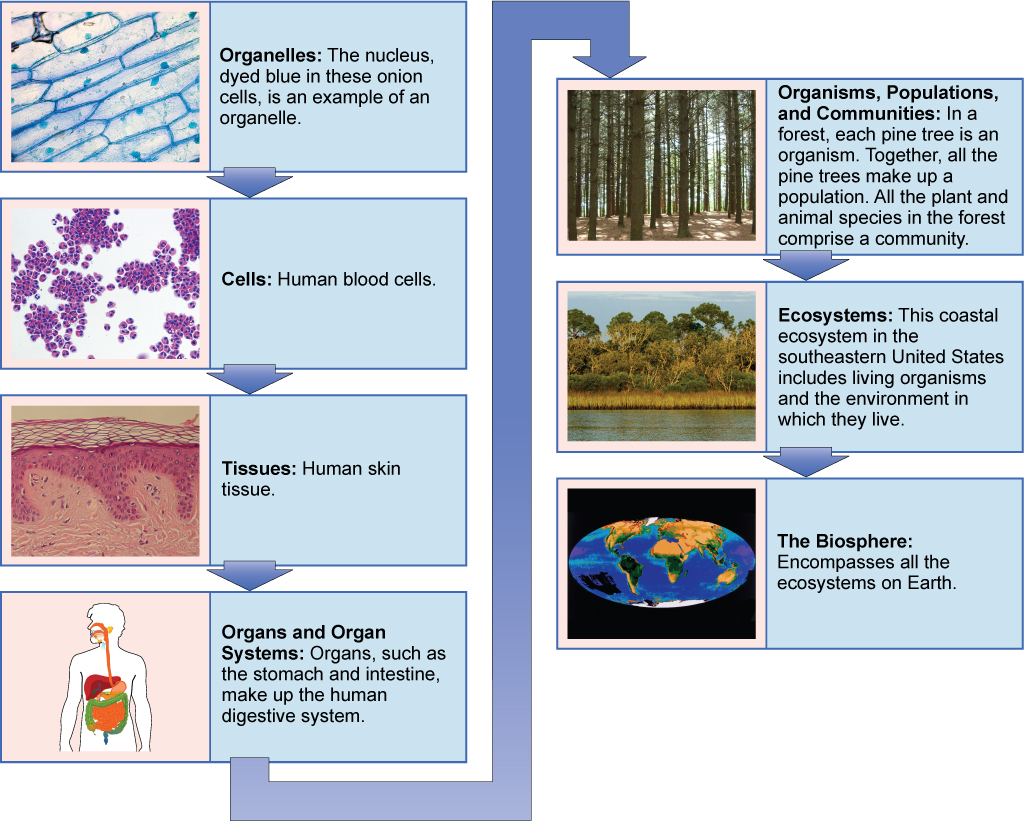
Did I Get It?
The Diversity of Life
When faced with the remarkable diversity of life, how do we organize the different kinds of organisms so that we can better understand them? As new organisms are discovered every day, biologists continue to seek answers to these and other questions. In this outcome, we will discuss taxonomy, which both demonstrates the vast diversity of life and tries to organize these organisms in a way we can understand.
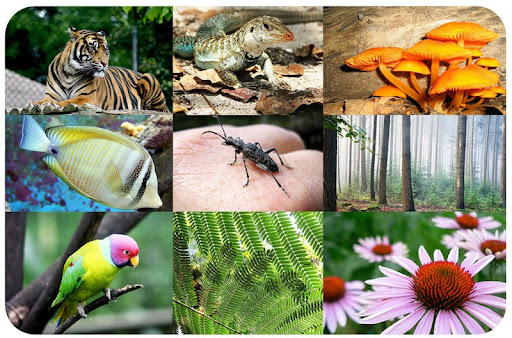
Biological diversity is the variety of life on earth. This diversity includes all the different plants, animals, and microorganisms, the genes they contain, and the ecosystems they form on land and in water. Biological diversity is constantly changing. It is increased by new genetic variation and reduced by extinction and habitat degradation.
What Is Biodiversity?
Biodiversity refers to the variety of life and its processes, including the variety of living organisms, the genetic differences among them, and the communities and ecosystems in which they occur. Scientists have identified about 1.9 million species alive today. They are divided into the six kingdoms of life shown in Figure 3. Scientists are still discovering new species. Thus, they do not know for sure how many species really exist today. Most estimates range from 5 to 30 million species.

Biologists, however, are always alert to levels of organization and have identified three unique measures of life’s variation:
-
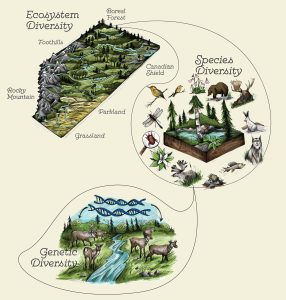
Figure 5. Although all three levels of diversity are important, the term biodiversity usually refers to species diversity! The most precise measure of biodiversity is genetic diversity or genetic variation within a species. This measure of diversity looks at differences among individuals within a population or at differences across different populations of the same species.
- The level just broader is species diversity, which best fits the literal translation of biodiversity: the number of different species in a particular ecosystem or on Earth. This type of diversity simply looks at an area and reports what can be found there.
- At the broadest, most encompassing level, we have ecosystem diversity. As Leopold clearly understood, the “cogs and wheels” include not only life but also the land, sea, and air that support life. In ecosystem diversity, biologists look at the many types of functional units formed by living communities interacting with their environments.
Although all three levels of diversity are important, the term biodiversity usually refers to species diversity!
Watch this discussion about biodiversity:
Biodiversity provides us with all of our food. It also provides for many medicines and industrial products, and it has great potential for developing new and improved products for the future. Perhaps most importantly, biological diversity provides and maintains a wide array of ecological “services.” These include the provision of clean air and water, soil, food, and shelter. The quality—and the continuation— of our life and our economy is dependent on these “services.”
Australia’s Biological Diversity
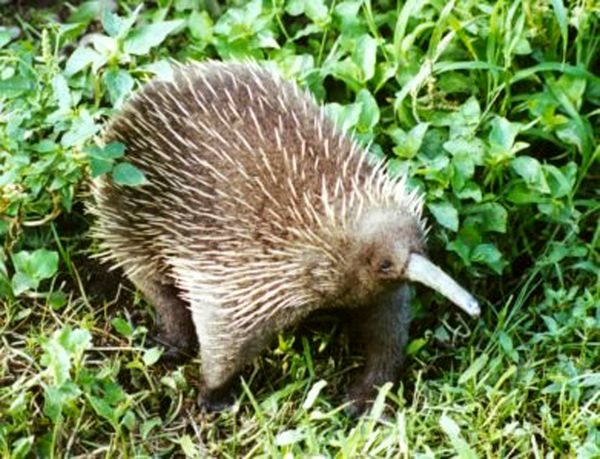
The long isolation of Australia over much of the last 50 million years and its northward movement have led to the evolution of a distinct biota. Significant features of Australia’s biological diversity include:
- A high percentage of endemic species (that is, they occur nowhere else):
- over 80% of flowering plants
- over 80% of land mammals
- 88% of reptiles
- 45% of birds
- 92% of frogs
- Wildlife groups of great richness. Australia has an exceptional diversity of lizards in the arid zone, many ground orchids, and a total invertebrate fauna estimated at 200,000 species, with more than 4,000 different species of ants alone. Marsupials and monotremes collectively account for about 56% of native terrestrial mammals in Australia.
- Wildlife of major evolutionary importance. For example, Australia has 12 of the 19 known families of primitive flowering plants, two of which occur nowhere else. Some species, such as the Queensland lungfish and peripatus, have remained relatively unchanged for hundreds of millions of years.
Did I Get It?
Phylogenetic Trees
The fact that biology, as a science, has such a broad scope has to do with the tremendous diversity of life on earth. The source of this diversity is evolution, the process of gradual change in a population or species over time. Evolutionary biologists study the evolution of living things in everything from the microscopic world to ecosystems.
In scientific terms, the evolutionary history and relationship of an organism or group of organisms is called phylogeny. Phylogeny describes the relationships of one organism to others—such as which organisms it is thought to have evolved from, which species it is most closely related to, and so forth. Phylogenetic relationships provide information on shared ancestry but not necessarily on how organisms are similar or different.
Scientists use a tool called a phylogenetic tree to show the evolutionary pathways and connections among organisms. A phylogenetic tree is a diagram used to reflect evolutionary relationships among organisms or groups of organisms. Scientists consider phylogenetic trees to be a hypothesis of the evolutionary past since one cannot go back to confirm the proposed relationships. In other words, a “tree of life” can be constructed to illustrate when different organisms evolved and to show the relationships among different organisms (Figure 6).

A phylogenetic tree can be read as a map of evolutionary history. Many phylogenetic trees have a single lineage at the base representing a common ancestor. Scientists call such trees rooted, which means there is a single ancestral lineage (typically drawn from the bottom or left) to which all organisms represented in the diagram relate. Notice in the rooted phylogenetic tree that the three domains—Bacteria, Archaea, and Eukarya—diverge from a single point and branch off. The small branch that plants and animals (including humans) occupy in this diagram shows how recent and minuscule these groups are compared with other organisms. Unrooted trees don’t show a common ancestor but do show relationships among species.
Did I Get It?
Taxonomy
Taxonomy (which literally means “arrangement law”) is the science of classifying organisms to construct internationally shared classification systems, with each organism placed into more and more inclusive groupings. Think about how a grocery store is organized. One large space is divided into departments, such as produce, dairy, and meats. Then each department further divides into aisles, then each aisle into categories and brands, and then finally, a single product. This organization, from larger to smaller, more specific categories, is called a hierarchical system.
The taxonomic classification system (also called the Linnaean system after its inventor, Carl Linnaeus, a Swedish botanist, zoologist, and physician) uses a hierarchical model. Moving from the point of origin, the groups become more specific until one branch ends as a single species. For example, after the common beginning of all life, scientists divide organisms into three large categories called a domain: Bacteria, Archaea, and Eukarya. Within each domain is a second category called a kingdom. After kingdoms, the subsequent categories of increasing specificity are phylum, class, order, family, genus, and species (Figure 7).
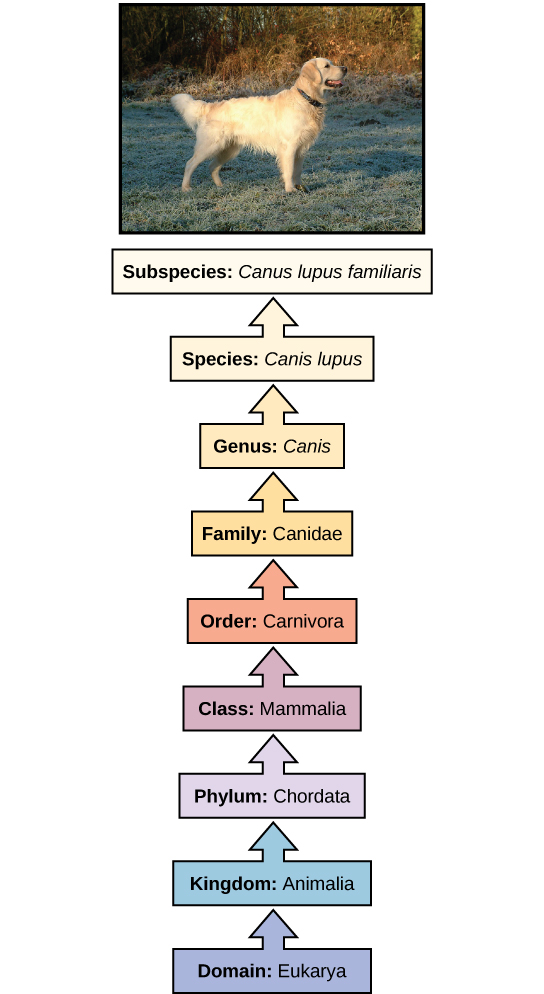
The kingdom Animalia stems from the Eukarya domain. For the common dog, the classification levels would be as shown in Figure 7. Therefore, the full name of an organism technically has eight terms. For the dog, it is Eukarya, Animalia, Chordata, Mammalia, Carnivora, Canidae, Canis, and Lupus. Notice that each name is capitalized except for species, and the genus and species names are italicized. Scientists generally refer to an organism only by its genus and species, which is its two-word scientific name, in what is called binomial nomenclature. Each species has a unique binomial nomenclature to allow for proper identification.
Therefore, the scientific name of the dog is Canis lupus.
When calling an organism by its specific binomial, the correct formatting (capitalization and italics) is important.
The name at each level is also called a taxon. In other words, dogs are in the order Carnivora. Carnivora is the name of the taxon at the order level; Canidae is the taxon at the family level, and so forth. Organisms also have a common name that people typically use, in this case, dog. Note that the dog is additionally a subspecies: the “familiaris” in Canis lupus familiaris. Subspecies are members of the same species that are capable of mating and reproducing viable offspring. Still, they are considered separate subspecies due to geographic or behavioral isolation or other factors.
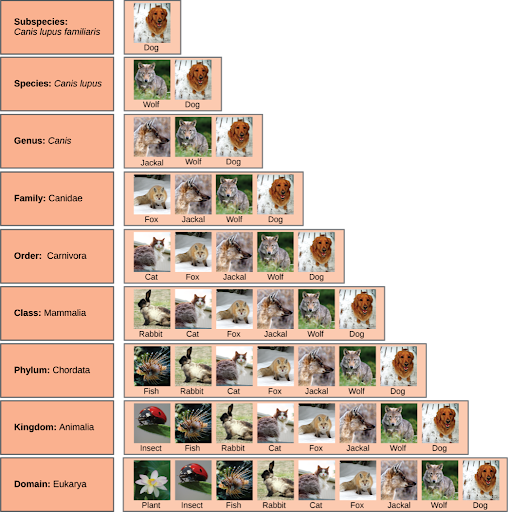
At what levels are cats and dogs considered to be part of the same group?
Check answer
Cats and dogs are part of the same group at five levels: both are in the domain Eukarya, the kingdom Animalia, the phylum Chordata, the class Mammalia, and the order Carnivora.
Did I Get It?
CC Licensed Content, Shared Previously, Included in Introduction to the Organisms
- Biology 2e. Authors: Mary Ann Clark, Matthew Douglas and Jung Choi. Provided by: OpenStax CNX. Located at: Biology 2e. License: CC BY: Attribution 4.0.
- Biology for Majors II. Authors: Shelly Carter and Monisha Scott. Provided by: Lumen Learning. Located at: Biology for Majors II | Simple Book Production. License: CC BY: Attribution 4.0.
- Themes and Concepts of Biology – Biology Part I. Authors: Jung Choi, Mary Ann Clark, and Matthew Douglas. Provided by: Pressbooks. Located at: 3. Themes and Concepts of Biology License: CC BY: Attribution 4.0.

